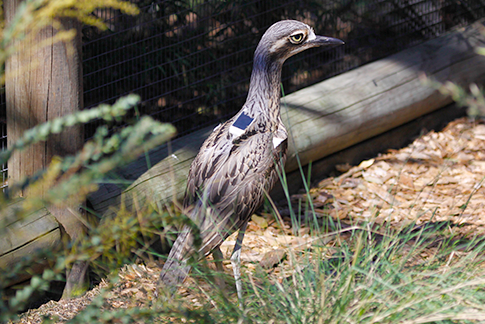Native to Australia, the Bush Stone-curlew (Burhinus grallarius) is Endangered in Victoria (there are fewer than 300 breeding pairs left on the Northern Victorian Plains) and NSW due to large-scale habitat destruction and fragmentation, and introduced predators. The curious curlews feed and nest on the ground which makes the preservation of fallen timber and woody debris within their open grassy woodland habitat a priority.
Bush Stone-curlew tracker trial
Text and images by Ashley Herrod, Avian Threatened Species Program Coordinator, Moonlit Sanctuary
Moonlit Sanctuary has been keeping and breeding Bush Stone-curlews Burhinus grallarius for over ten years. We currently have two breeding which are housed in separate display enclosures at the park. They are a lovely species to have in the collection, with their long legs, big beady eyes, mournful call and expertly-camouflaged plumage. Often visitors will not even know there is a curlew right in front of them!
Trust for Nature operate a curlew conservation program in northern Victoria. Captive-bred curlews released in the wild supplement the wild population where the species is in decline. Monitoring curlews post-release has however proved tricky because of their cryptic nature and ability to disperse far from the point of release. Trust for Nature approached Moonlit Sanctuary seeking a collaboration to develop a method of attaching GPS tracking devices to curlews for long-term post-release monitoring.
Commencing in June 2018, we produced two harness designs made from Teflon ribbon: a back-pack style harness and a leg-loop harness, which attached to 17 g solar-powered GPS satellite tracking devices (non-operational). The harnesses were fitted to five of our eight curlews (three adults and two offspring spread across the two families), with the other three curlews acting as control birds. We carried out weekly health checks over a period of six weeks, of all eight curlews after the harnesses were fitted, to monitor the birds’ weight, feather and skin condition. We also monitored the birds’ behaviour via daytime observations and video recorded at night with wildlife monitoring cameras setup in the enclosures. We then compared all of these parameters between the group of curlews wearing harnesses and the control group of curlews.
24 hours after the harness were fitted, the Teflon ribbon was invisible, having been preened among the body feathers by the birds wearing them. The only visible component of the harness package was the tracking device. One harness was removed from a bird one week after being fitted because it was slightly too loose and was mildly rubbing the bird’s feathers. The remaining four harnesses did not cause any wear to the feathers or skin throughout the six-week trial, and fitted snugly on the birds. On average both the harness group and control group lost weight during the trial; 0.6% and 3.3% respectively. This is a negligible weight loss based on our years of weigh records, and as both groups of curlews lost weight, it suggests it is not related to wearing a harness. Their overall health, body condition, and feather quality remained in great condition.
Both groups of birds exhibited a range of typical behaviour during the trial, suggesting the harnesses did not impair behaviour such as flight, preening, foraging, sitting, walking, or running.
One week before the trial was due to end, both breeding pairs began constructing nests and then laid their first eggs of the 2018/19 breeding season. This was great news, because it showed that the harnesses did not perturb the birds from commencing to breed. We have removed the harnesses off the two offspring that were wearing them, and moved both sets of offspring out of the parents’ enclosures due to observed aggression from the parents as a result of breeding. We left the harnesses on the two adults (one from each breeding pair) and it did not affect their ability to breed: both pairs went on to hatch and raise chicks to independence, which provides further valuable information regarding the suitability of the harnesses on Bush Stone-curlews.
The tracker trial has been a successful project to undertake, providing valuable information regarding the efficacy of harnesses as a method of attaching tracking devices to Bush Stone-curlews. We hope the results of the trial will guide efforts to successfully monitor captive-bred Bush Stone-curlews released in to the wild.
Moonlit Sanctuary’s Avian Threatened Species Program Coordinator, Ashley Herrod, led the captive trial:
“The captive tracker trial program on our Bush Stone-curlews was a success. The trial protocols consisted of regular health checks of harnessed and control birds’ weights and body condition, plus observation of their behaviour carried out by human observers and trail cameras. We have generated some valuable information and knowledge about fitting tracking devices to Bush Stone-curlews for long-term post-release monitoring in collaboration with Trust for Nature, which will be shared to other groups involved in the species’ conservation.”
Since opening in 1998, Moonlit Sanctuary Wildlife Conservation Park has become an advocate of Australian wildlife preservation. Thanks to high-level expertise in modern zookeeping, the Sanctuary’s keepers use their experience and skills on a range of captive husbandry and management programs.

